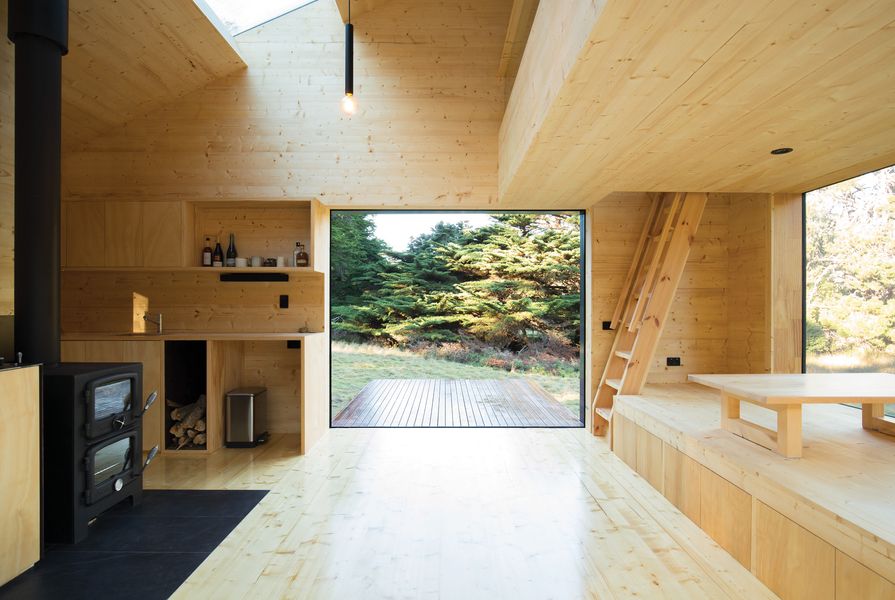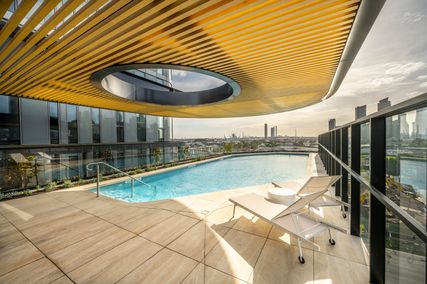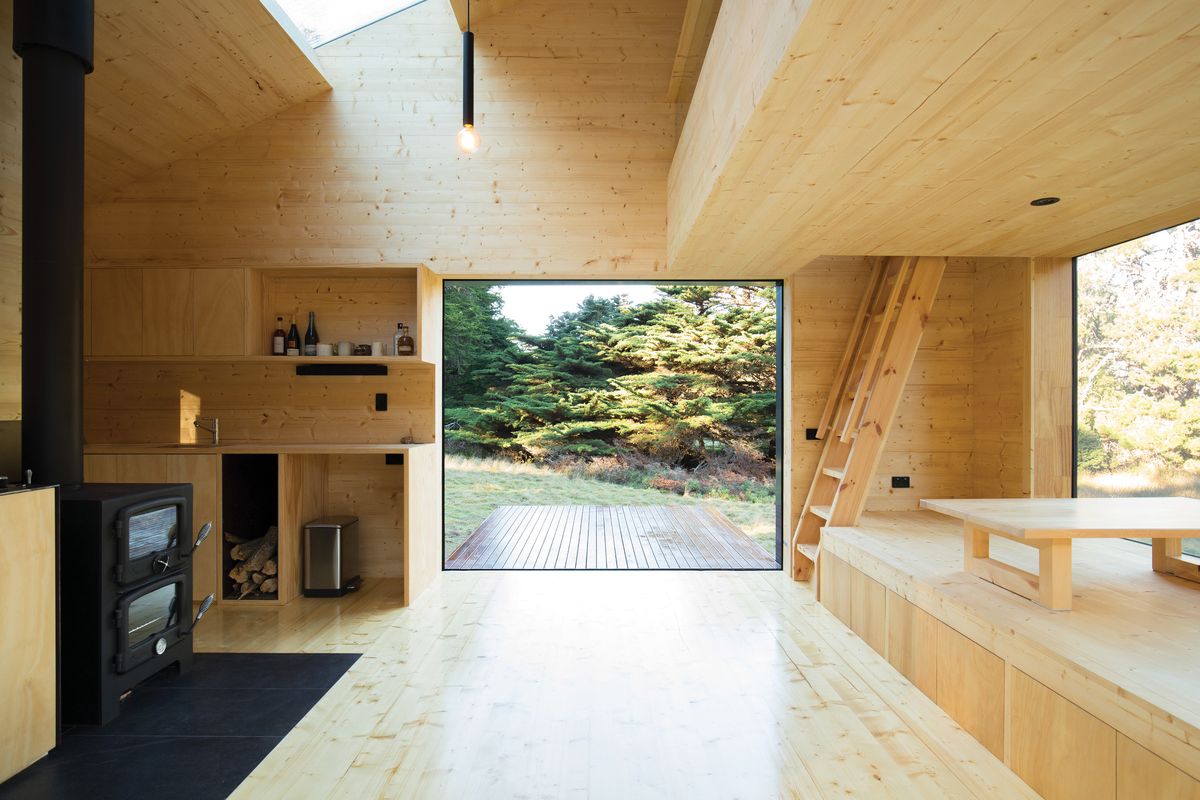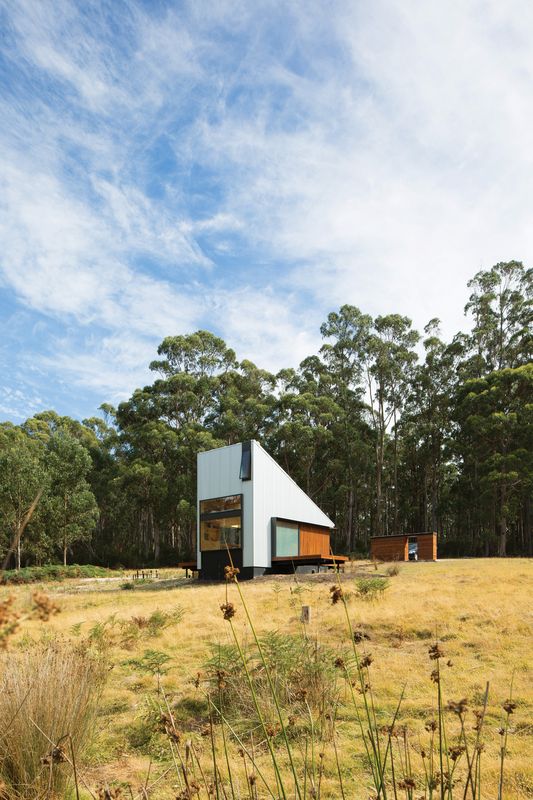If you’ve camped frequently or for long enough, you will discover there is a “place” for your items and a “way” to use them. A fine understanding of what happens when the rain falls, how to see the stars at night while staying out of the wind and how to fit everything you need into your bag comes from experience and reflection, and can be a great source of pride when achieved. Sophia Shih’s cabin, nestled within the hills of Tasmania’s Bruny Island, is a refined illustration of this. Sophia met architects Hugh Maguire and Dan Devine of Hobart-based Maguire and Devine Architects through a mutual friend, who had spoken with the pair about cabins while hiking.
The roof of the cabin angles towards the northern sun for the solar panels and allows space for a mezzanine sleeping loft to the south.
Image: Rob Maver
Bruny Island Cabin offers deliverance for the client, a place for her to escape from the “real” world while also acknowledging her place in it. With a choice of sites on a large bush property with coastal views, Sophia and the architects decided on a calm place among the eucalypts, a place that is still in comparison to the dynamic nearby ocean. Once you leave the main road on your way to the property, the dirt road curves up the hill away from houses that look north to the bays separating the island from the mainland. You then enter a dense eucalypt forest before an expansive valley clearing, climbing away at the south toward Mount Mangana. To make the most of the view, the cabin is maintained toward the northern edge of a smaller clearing within the larger property, a siting that provides a balance of solitude and embrace.
To minimize the extent of the driveway, the architects maintained the entrance pergola, which houses the wood store, gas bottles and essential tools, close to the immediate site boundary, formally aligned with the cabin. This hides the car from the house, and enforces a threshold by encouraging the visitor to leave their vehicle behind the wood store and only carry into the cabin what they need. The glazed entrance door frames an inviting view to the light, honeyed timbers of the cocoon-like interior. The flooring is in Baltic pine, designed for bare feet or socks only. The minimal interior, prescriptively without any loose furniture that might clutter the solitude, is dominated by the large southern window that frames a view of the layered landscape, something reminiscent of a painting by John Glover, the English landscape artist who moved to Tasmania in the 1830s. This view remains the singular constant in the cabin, without blinds to close it off. The large east and west sliding doors that flank the open-plan space are frosted, providing a blinkered sense of enclosure but also preventing confused birds, including the endangered swift parrot, from flying into the glass. Through day and night the “painting” in the window transforms in colour and texture; pen changes to brush, sharp lines to soft.
The east and west sliding doors that flank the living area are frosted, providing a sense of enclosure and preventing birds from flying into the glass.
Image: Rob Maver
In the morning the eastern sliding door is opened to a timber deck, the merbau chosen for its inherent fire-resistant properties. The western door is also opened, flushing air through the cabin and creating a central platform to the greater clearing. When guests come to camp, the cabin becomes the main hut, and much like the miniscule timber huts on many of Tasmania’s great hikes, it is a place to congregate and hide food from possums before retreating to the seclusion of your tent. The bathroom has a concealed door to the entrance deck, covered subtly by the extended eaves, which allows campers access to the toilet at night without disturbing the main body of the space. The western deck holds a bath, for bathing in the open while gazing up at the gum trees and across the gully.
The entrance to the cabin is marked by a small pergola holding the wood store and gas bottles that acts as a screen for cars.
Image: Rob Maver
A steep loft stair climbs to a mattress-on-the-timber loft bed, with a horizontal fixed glazed window again providing an uninterrupted view to the south. From the bed the aurora australis, the southern lights, can be seen advancing and retreating from the pole. Under the loft, a raised platform that doubles as storage houses a Japanese-style sitting table, a small bookshelf and Sophia’s violins; it is a place where she joins the symphony of the songbirds when taking a week away from work as a doctor. “When I arrive at the gate, all the aches and pains disappear, literally,” she says.
The cabin, away from mains services, is completely off the grid. It was important to Sophia that this is not apparent; the water supply and recycling tanks are buried, and the solar panels, roof and roof windows are as one, rather than conspicuous later attachments. Maguire and Devine Architects had specific instructions to provide all the simplicities of the modern world in a cabin away from it all – and their experience traversing the island has allowed them to create just that.
Products and materials
- Roofing
- Lysaght Custom Orb in Zincalume.
- External walls
- Merbau boards in Intergrain Natural Stain; Lysaght Custom Orb in Zincalume.
- Internal walls
- Baltic pine boards in tung oil.
- Windows
- Capral 406 St Lucia framing powdercoated in Dulux ‘Monument’.
- Doors
- Capral external-track sliding door in Dulux ‘Monument’.
- Flooring
- Baltic pine floorboards in Feast Watson Floorseal Tung Oil.
- Kitchen
- Milli Axon mixer; Zum Piccolo black granite sink; De’Longhi gas cooktop.
- Bathroom
- Panaria Urbanature cement tiles; Scala wall outlet; Milli Pure basin mixer; Alape Unisono glazed steel basin; Dama Senso toilet.
- Heating and cooling
- Nectre Bakers Oven wood heater and oven; Bosch 4000s Internal Instantaneous gas hot water system.
- External elements
- Merbau decking in Intergrain decking oil.
- Other
- Custom Huon pine table by Dare by Design.
Credits
- Project
- Bruny Island Cabin
- Architect
- Maguire and Devine Architects
Hobart, Tas, Australia
- Project Team
- Daniel Devine, Hugh Maguire
- Consultants
-
Builder
Merlin Constructions
Engineer Stephen Cole Consulting Engineer
- Site Details
-
Location
Bruny Island,
Tas,
Australia
Site type Coastal
Site area 40000 m2
Building area 28 m2
- Project Details
-
Status
Built
Completion date 2017
Design, documentation 14 months
Construction 4 months
Category Residential
Type New houses
Source
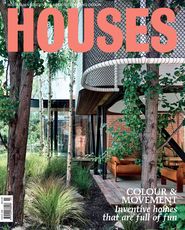
Project
Published online: 18 Sep 2018
Words:
Sam Whinnett
Images:
Maguire and Devine Architects,
Rob Maver
Issue
Houses, June 2018

